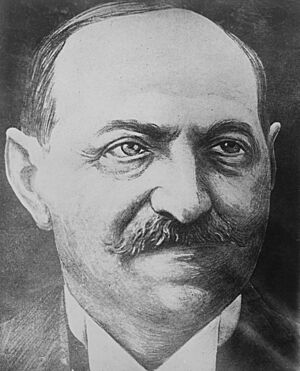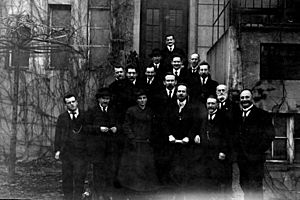Hugo Haase facts for kids
Quick facts for kids
Hugo Haase
|
|
|---|---|

Hugo Haase
|
|
| Leader of the Independent Social Democratic Party | |
| In office 6 April 1917 – 7 November 1919 |
|
| Serving with | Georg Ledebour (1917–1919) Arthur Crispien (1919–1922) |
| Preceded by | Party established |
| Succeeded by | Ernst Däumig |
| Leader of the Social Democratic Party | |
| In office 16 September 1911 – 25 March 1916 |
|
| Serving with | August Bebel (1892–1913) Friedrich Ebert (1913–1919) |
| Preceded by | Paul Singer |
| Succeeded by | Philipp Scheidemann |
| Member of the Reichstag for Königsberg 3 |
|
| In office 12 January 1912 – 9 November 1918 |
|
| Preceded by | Robert Gyßling |
| Succeeded by | Constituency abolished |
| In office 14 June 1897 – 24 January 1907 |
|
| Preceded by | Carl Schultze |
| Succeeded by | Robert Gyßling |
| Personal details | |
| Born | 29 September 1863 Allenstein, East Prussia |
| Died | 7 November 1919 (aged 56) Berlin, Weimar Republic |
| Cause of death | Blood poisoning from the gunshot wound |
| Political party | SPD (1887–1916) USPD (1917–1919) |
| Spouse | Thea Lichtenstein |
| Children | Ernst Haase |
| Alma mater | University of Königsberg |
Hugo Haase (born September 29, 1863 – died November 7, 1919) was an important German politician. He was a socialist, which means he believed in a society where everyone is equal. He was also a lawyer and a pacifist, meaning he was against war.
Haase helped lead Germany's government for a short time during the German Revolution of 1918–19. He worked with Friedrich Ebert in a group called the Council of the People's Deputies.
Contents
Early Life and Career
Hugo Haase was born in Allenstein, Germany, which is now Olsztyn, Poland. His father, Nathan Haase, was a shoemaker.
Haase studied law in Königsberg, now Kaliningrad, Russia. In 1887, he joined the Social Democratic Party of Germany (SPD). This party worked to improve the lives of workers. The next year, he became a lawyer. He was the first socialist lawyer in his area. He often helped workers, farmers, and journalists with their legal problems.
In 1894, Haase became the first Social Democrat to join the local city council in Königsberg. Three years later, in 1897, he was elected to the Reichstag. The Reichstag was like Germany's parliament or main law-making body.
Haase became well-known for defending Social Democrats in court. These people were often charged with crimes because of their political beliefs. For example, in 1904, he helped several politicians get found not guilty in a famous case. In 1907, he defended Karl Liebknecht, another SPD member. Liebknecht was accused of treason for writing a book against the military.
Haase believed in making changes to society slowly, through reforms. He didn't think a sudden revolution was the best way. In 1911, he became a leader of the SPD party. He worked alongside August Bebel and later Friedrich Ebert. Haase continued to work as a lawyer, even while being a top politician.
World War I and New Party
In July 1914, Hugo Haase organized meetings for the SPD to protest against war. When Germany decided to enter World War I, the SPD had to vote on whether to support the war. Haase and 13 other SPD members did not want to support the war. However, to show party unity, Haase voted for the war loans in the Reichstag. As a party leader, he had to announce the SPD's support for the war. He read a statement saying the party would "not abandon the Fatherland." This support helped create a policy called Burgfrieden, which meant political parties would stop fighting each other during the war.
As the war continued, Haase became more and more against it. He disagreed with the main SPD leaders. In 1915, he had to step down as a leader in the Reichstag. In March 1916, Haase and 18 other SPD members voted against the government's emergency budget for the war. Because of this, he had to resign as the SPD party chairman.
After leaving the SPD, Haase formed a new group called the Socialist Working Group. In April 1917, he became the leader of a brand new party: the Independent Social Democratic Party of Germany (USPD). This new party broke away from the main SPD. The USPD wanted Germany to start peace talks right away to end the war.
German Revolution and Government Role
In November 1918, the German Revolution of 1918–19 began. The German Empire ended, and a new government was formed. Hugo Haase became a co-leader of this new temporary government, called the Council of the People's Deputies. He shared this role with Friedrich Ebert, the leader of the main SPD party.
Haase did not agree with some people in his own USPD party. They wanted to create a "dictatorship of the proletariat," which meant workers and soldiers would have total power. Haase preferred a more democratic approach.
During Christmas 1918, there was a conflict where the government used force against a group of revolutionary sailors. Haase and two other USPD members left the government on December 29 to protest this action.
Even after leaving the government, Haase still wanted the USPD to work with the main SPD party. He also supported holding elections for a new national assembly. This assembly would create a new constitution for Germany. Many in his party preferred a system based on workers' councils instead of elections.
The main SPD party didn't like Haase very much. This was because the USPD offered another choice for workers who wanted more radical changes. The USPD pushed the SPD to take a more left-wing path. This made it harder for the SPD to manage the country, feed people, keep order, and change Germany from an empire to a republic.
In the elections for the new assembly on January 19, 1919, Haase's USPD party received 7% of the votes.
Death
On October 8, 1919, Hugo Haase was going into the Reichstag building. He planned to reveal information about a general named Rüdiger von der Goltz. As Haase entered, a man named Johann Voss shot him. Voss was later declared mentally ill. Some people believed Voss was hired to kill Haase.
Haase was badly hurt and died on November 7, 1919. He is remembered at the Memorial to the Socialists in the Friedrichsfelde Central Cemetery in Berlin.
Hugo Haase was married to Thea Lichtenstein. They had three children: a son named Ernst and two daughters, Gertrude and Hilde.
See also
- List of peace activists
Images for kids
-
Tomb of Hugo Haase in Berlin.



